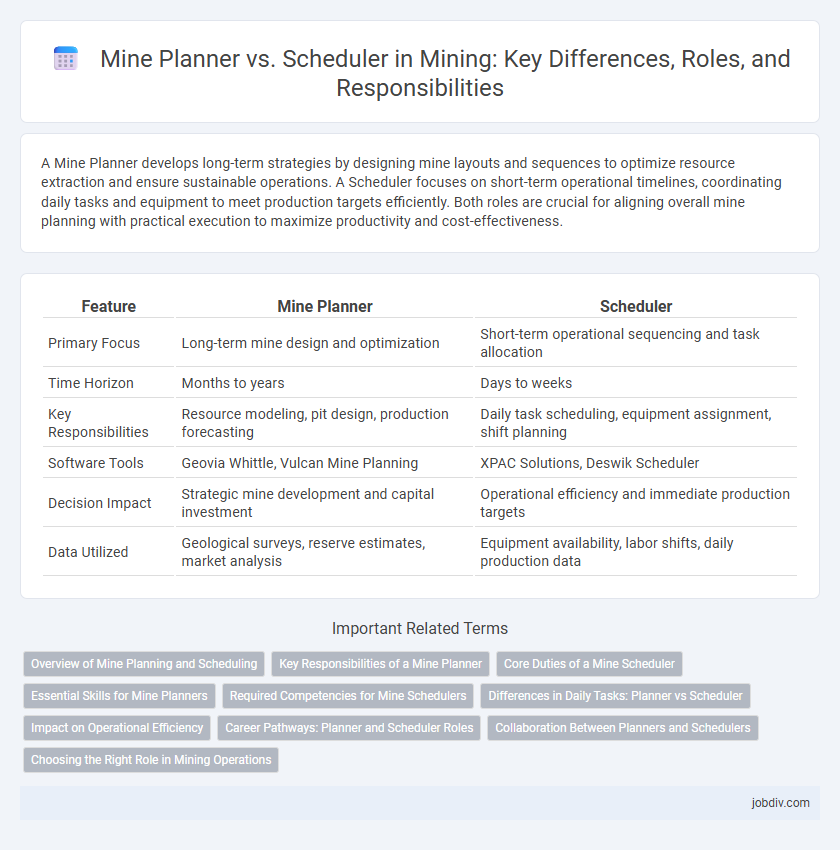A Mine Planner develops long-term strategies by designing mine layouts and sequences to optimize resource extraction and ensure sustainable operations. A Scheduler focuses on short-term operational timelines, coordinating daily tasks and equipment to meet production targets efficiently. Both roles are crucial for aligning overall mine planning with practical execution to maximize productivity and cost-effectiveness.
Table of Comparison
| Feature | Mine Planner | Scheduler |
|---|---|---|
| Primary Focus | Long-term mine design and optimization | Short-term operational sequencing and task allocation |
| Time Horizon | Months to years | Days to weeks |
| Key Responsibilities | Resource modeling, pit design, production forecasting | Daily task scheduling, equipment assignment, shift planning |
| Software Tools | Geovia Whittle, Vulcan Mine Planning | XPAC Solutions, Deswik Scheduler |
| Decision Impact | Strategic mine development and capital investment | Operational efficiency and immediate production targets |
| Data Utilized | Geological surveys, reserve estimates, market analysis | Equipment availability, labor shifts, daily production data |
Overview of Mine Planning and Scheduling
Mine planning involves designing the layout, extraction sequence, and resource allocation to optimize ore recovery and operational efficiency over the mine's life. Mine scheduling focuses on short-term execution, detailing when and where specific mining activities occur to meet production targets and optimize equipment usage. Both roles are critical for aligning strategic objectives with operational constraints in mining projects.
Key Responsibilities of a Mine Planner
A Mine Planner develops detailed mining plans that optimize resource extraction, incorporating geological data, equipment capabilities, and production schedules. They analyze ore bodies, design mine layouts, and ensure compliance with safety and environmental regulations. Key responsibilities include forecasting production targets, coordinating with geologists and engineers, and adjusting plans based on operational constraints to maximize efficiency.
Core Duties of a Mine Scheduler
A Mine Scheduler develops detailed timelines for mining operations, ensuring optimal resource allocation and adherence to project deadlines. Core duties include creating production schedules, coordinating equipment availability, and monitoring daily progress to adjust plans accordingly. Effective scheduling maximizes efficiency, reduces downtime, and supports overall mine productivity.
Essential Skills for Mine Planners
Mine planners require comprehensive skills in geological data analysis, resource estimation, and mine design software such as Surpac and Datamine to optimize extraction processes. Proficiency in production scheduling, cost optimization, and regulatory compliance ensures efficient and sustainable mine operation planning. Strong communication skills enable mine planners to coordinate effectively with engineers, geologists, and schedulers, aligning strategic objectives with operational execution.
Required Competencies for Mine Schedulers
Mine schedulers require strong skills in resource allocation, project management, and proficiency in scheduling software like MS Project or Primavera. They must possess analytical abilities to interpret geological data and adapt plans to operational constraints and safety standards. Effective communication and coordination with engineering teams and field operators are essential to ensure timely and cost-effective mining operations.
Differences in Daily Tasks: Planner vs Scheduler
Mine planners focus on designing long-term extraction strategies, including resource modeling, mine layout optimization, and sequencing of mining operations to maximize resource recovery. Schedulers allocate daily tasks by assigning specific crews, equipment, and shifts, ensuring operational efficiency and adherence to production targets on a short-term basis. While planners develop the overarching mining plan, schedulers optimize daily workflows to meet the plan's objectives.
Impact on Operational Efficiency
Mine planners design long-term extraction strategies maximizing resource recovery and reducing waste, directly influencing overall mine productivity. Schedulers create detailed short-term timetables that optimize daily operations and equipment utilization, minimizing delays and downtime. Effective collaboration between planners and schedulers enhances operational efficiency by aligning strategic goals with practical execution.
Career Pathways: Planner and Scheduler Roles
Mine planners focus on designing detailed mine layouts and long-term extraction plans to maximize resource efficiency and safety, often requiring expertise in geology and engineering. Schedulers develop and manage detailed production schedules to ensure operational targets and deadlines are met, relying on skills in project management and logistics. Career pathways for planners typically lead to roles in strategic mine development and resource management, while schedulers advance toward operational leadership and optimization roles within mining projects.
Collaboration Between Planners and Schedulers
Effective collaboration between mine planners and schedulers enhances operational efficiency by integrating strategic mine designs with detailed production timelines. Planners focus on resource allocation and long-term extraction plans while schedulers develop actionable daily and weekly schedules to optimize equipment and labor use. Seamless data sharing and synchronized workflows between these roles minimize downtime and improve overall productivity in mining operations.
Choosing the Right Role in Mining Operations
Mine planners develop detailed extraction strategies considering geological data, operational constraints, and long-term production goals to optimize resource recovery. Schedulers focus on short-term task allocation, equipment availability, and workforce management to ensure daily operational efficiency and timely project completion. Selecting the right role depends on aligning strategic planning needs with operational execution demands within mining projects.
Mine Planner vs Scheduler Infographic

 jobdiv.com
jobdiv.com